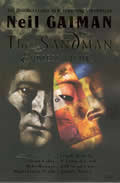
| Writer: | Neil Gaiman |
| Letterer: | Todd Klein |
| Publisher: | Vertigo |
| Copyright: | 2003 |
| ISBN: | 1-4012-0113-X |
| Format: | Graphic novel |
| Pages: | 157 |
I have loved every one of Neil Gaiman's books that I've read, but I still think he's a better comic book writer than a novelist. His books are solid, well-written fantasies that touch a sense of wonder and understanding of the strange, but his graphic novels are something apart.
The Sandman, Gaiman's ten-volume magnum opus, onto which he previously added two more volumes featuring Death that are as good as or better than anything in the main series, is simply a masterpiece of the medium and as beautiful of an exploration of mythology, humanity, and fate as I've read anywhere. It is, however, finished, the characters largely left in their final configurations, and this is not a continuation of it. Rather, this is seven new short stories, one for each of the Endless, each done by a different artist. They are explorations of themes, a revisiting of the Sandman world, and a small additional taste of the characters we remember.
For those who do not already know of the Endless and are new to Sandman, don't start here. While some of the stories stand on their own to a degree, others don't, and for all of them much of the depth will be lost if you haven't read the main story. This is, in many ways, an encore, which is not the time to walk in on the performance.
The stories are a bit scattered and experimental, interesting in some cases for their daring, but not quite as satisfying as Sandman itself or the two Death stories. This isn't the work that catapulted Gaiman into our attention, nor does it have as many of the perceptive insights and wonderful comments as his other work. Nonetheless, if you loved Sandman, you won't be disappointed. There are interesting bits of revelation here and some beautiful art, but more than anything else a reminder of just how good Sandman was.
"Death and Venice": Drawn by P. Craig Russell and colored by Lovern Kindzierski, this is one of the more traditional stories of the bunch. It tells of a man's encounter with Death, and how he helps her deal with a long-delayed problem. Alas, there isn't as much of Death in the story as one might have wished, and quite a lot of scene-setting, but when she does show up she's her wonderful self. Any Death story is a good one. (7)
"What I've Tasted of Desire": Milo Manara is the artist of a story that is fully as creepy as Desire itself. I never felt like Desire got quite enough screen time in The Sandman and remained something of an enigma throughout, and it was good to see a story that focused more on Desire's view of the world. The main character is both a victim and an interesting mirror of Desire's oddly unyielding tragedy. (8)
"The Heart of a Star": Miguelanxo Prado does a beautiful job with this, the earliest story ever told of the Endless. It's interesting as a curiosity, to see one of the first women Dream loved and the outcome of that love, to see Delight before Delirium, and to see, of all things, a taciturn and unsmiling Death. It's mostly just a tour of the early Endless and a simple story, though, with not a lot to hold one's attention beyond the references to later events. (7)
"Fifteen Portraits of Despair": One of the most experimental bits of this book, this isn't a story in any sense, but is instead fifteen separate works of art by Barron Storey, designed by Dave McKean and filled with disjointed bits of text by Gaiman, that capture some of the essence of Despair. It didn't do a lot for me, but it's disturbing and effective for what it is. (6)
"Going Inside": Another very experimental piece, this time illustrated by Bill Sienkiewicz, this is the story of several very different mentally ill people caught up in Delirium's wake. It is appropriately psychedelic and disturbing, but I was a little disappointed that there wasn't more of Delirium's "giddy profundity" here, mostly because she's out of it for much of the story. (6)
"On the Peninsula": I think this story, fairly conventionally drawn by Glenn Fabry and colored by Chris Chuckry, was my favorite of the collection. The down-to-earth simplicity of Destruction is a nice change of pace from the previous two bits, and here is Delirium the way I like her best. There isn't a lot of story, just the moments around an event captured, but Destruction and Delirium are wonderful together and something about Destruction just makes me like him. (8)
"Endless Nights": Destiny's story is not a story so much as an explanation, but it is hands-down the most beautiful work of art in this whole collection. The painted art by Frank Quitely is spectacular, capturing so well a sense of scale and scope for Destiny's walk that I lingered over every page. Wonderful work. (8)
Reviewed: 2005-02-10